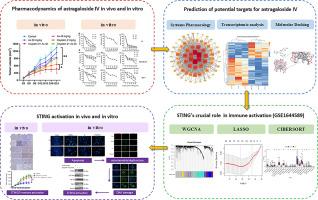Astragaloside IV potentiates cisplatin sensitivity in triple-negative breast cancer via STING signaling pathway activation
IF 8.3
1区 医学
Q1 CHEMISTRY, MEDICINAL
引用次数: 0
Abstract
Background
Astragaloside IV (As), a bioactive tetracyclic triterpenoid saponin from Astragalus membranaceus, exhibits diverse pharmacological properties including anti-inflammatory, anticancer and immunomodulatory activities. However, its potential role as a targeted therapeutic agent for cisplatin sensitization in triple-negative breast cancer (TNBC) via the STING signaling pathway remains unexplored.
Purpose
This study aimed to investigate the cisplatin-sensitizing potential of As in TNBC and elucidate its underlying molecular mechanisms.
Methods
Bioinformatic analysis identified key module genes from public databases using weighted gene co-expression network analysis (WGCNA), followed by feature selection via least absolute shrinkage and selection operator (LASSO) regression. Immune microenvironment characterization was performed using CIBERSORT deconvolution analysis. Potential targets of As in TNBC were systematically identified through multi-database mining, protein-protein interaction (PPI) network construction, pathway enrichment analysis and molecular docking simulations. Transcriptomic profiling revealed treatment-induced differentially expressed genes and enriched signaling pathways in murine tissues. The combinatorial anti-tumor efficacy was evaluated using orthotopic TNBC model (4T1 cell-derived) in vivo and 4T1, MDA-MB-231, and MCF-7 cell lines in vitro. Mechanistic validation was conducted through integrated in vivo and in vitro experiments.
Results
Integrated bioinformatics analysis (WGCNA, LASSO, and CIBERSORT) identified STING within a chemotherapy-sensitive module among six endoplasmic reticulum (ER)-associated gene co-expression networks. STING exhibited significant enrichment in antitumor immune pathways and correlated with heterogeneous immune cell infiltration. KEGG pathway analysis implicated immune/inflammatory signaling and DNA damage responses in the cisplatin-sensitizing effects of As. Molecular docking confirmed stable binding between As and STING (binding energy: -36.09 kcal/mol). In vivo, As synergistically enhanced cisplatin’s tumor growth inhibition while mitigating cisplatin-induced toxicity, including weight loss, nephrotoxicity, and systemic inflammation. Transcriptomic and immunohistochemical analyses validated As-mediated DNA damage, STING pathway activation, immune cell recruitment. In vitro mechanistic studies using DNase I and STING inhibitor (C-176) demonstrated As potentiated cisplatin via cell cycle arrest, mitochondrial dysfunction and STING cascade activation. C‐176 weakened the antitumor activity of As- cisplatin combination treatment.
Conclusion
As synergistically enhances the therapeutic efficacy of cisplatin against TNBC while ameliorating its adverse effects, primarily through activation of the STING signaling pathway and potentiation of antitumor immunity. This dual mechanism—simultaneously boosting host defense ("Fuzheng") and inhibiting tumor progression ("Kang`ai")—provides a molecular basis for the observed "Qi-tonifying" properties of As in traditional Chinese medicine (TCM), bridging TCM with contemporary immunopharmacology.

黄芪甲苷通过STING信号通路激活增强三阴性乳腺癌顺铂敏感性。
背景:黄芪甲苷(Astragaloside IV, As)是一种具有生物活性的四环三萜皂苷,具有抗炎、抗癌和免疫调节等多种药理作用。然而,其作为三阴性乳腺癌(TNBC)通过STING信号通路顺铂致敏的靶向治疗剂的潜在作用仍未被探索。目的:本研究旨在探讨As在TNBC中的顺铂致敏潜能,并阐明其潜在的分子机制。方法:生物信息学分析采用加权基因共表达网络分析(WGCNA)从公共数据库中识别关键模块基因,然后通过最小绝对收缩和选择算子(LASSO)回归进行特征选择。免疫微环境表征采用CIBERSORT反卷积分析。通过多数据库挖掘、蛋白相互作用(protein-protein interaction, PPI)网络构建、通路富集分析和分子对接模拟等方法,系统鉴定了As在TNBC中的潜在靶点。转录组学分析揭示了小鼠组织中治疗诱导的差异表达基因和丰富的信号通路。采用原位TNBC模型(4T1细胞衍生)体内和4T1、MDA-MB-231和MCF-7细胞系体外联合抗肿瘤效果评估。通过体内和体外综合实验进行机理验证。结果:综合生物信息学分析(WGCNA, LASSO和CIBERSORT)在六个内质网(ER)相关基因共表达网络中确定了化疗敏感模块中的STING。STING在抗肿瘤免疫通路中显著富集,并与异质免疫细胞浸润相关。KEGG通路分析暗示免疫/炎症信号和DNA损伤反应在顺铂致敏效应中的作用。分子对接证实As与STING结合稳定(结合能:-36.09 kcal/mol)。在体内,As协同增强了顺铂的肿瘤生长抑制作用,同时减轻了顺铂诱导的毒性,包括体重减轻、肾毒性和全身炎症。转录组学和免疫组织化学分析证实了as介导的DNA损伤、STING通路激活和免疫细胞募集。使用DNase I和STING抑制剂(C-176)进行的体外机制研究表明,As通过细胞周期阻滞、线粒体功能障碍和STING级联激活来增强顺铂的作用。C-176降低了顺铂联合治疗的抗肿瘤活性。结论:As主要通过激活STING信号通路和增强抗肿瘤免疫,协同提高顺铂治疗TNBC的疗效,同时改善其不良反应。这种双重机制——同时增强宿主防御(“扶正”)和抑制肿瘤进展(“康爱”)——为中医中观察到的砷的“补气”特性提供了分子基础,架起了中医与当代免疫药理学的桥梁。
本文章由计算机程序翻译,如有差异,请以英文原文为准。
求助全文
约1分钟内获得全文
求助全文
来源期刊

Phytomedicine
医学-药学
CiteScore
10.30
自引率
5.10%
发文量
670
审稿时长
91 days
期刊介绍:
Phytomedicine is a therapy-oriented journal that publishes innovative studies on the efficacy, safety, quality, and mechanisms of action of specified plant extracts, phytopharmaceuticals, and their isolated constituents. This includes clinical, pharmacological, pharmacokinetic, and toxicological studies of herbal medicinal products, preparations, and purified compounds with defined and consistent quality, ensuring reproducible pharmacological activity. Founded in 1994, Phytomedicine aims to focus and stimulate research in this field and establish internationally accepted scientific standards for pharmacological studies, proof of clinical efficacy, and safety of phytomedicines.
 求助内容:
求助内容: 应助结果提醒方式:
应助结果提醒方式:


